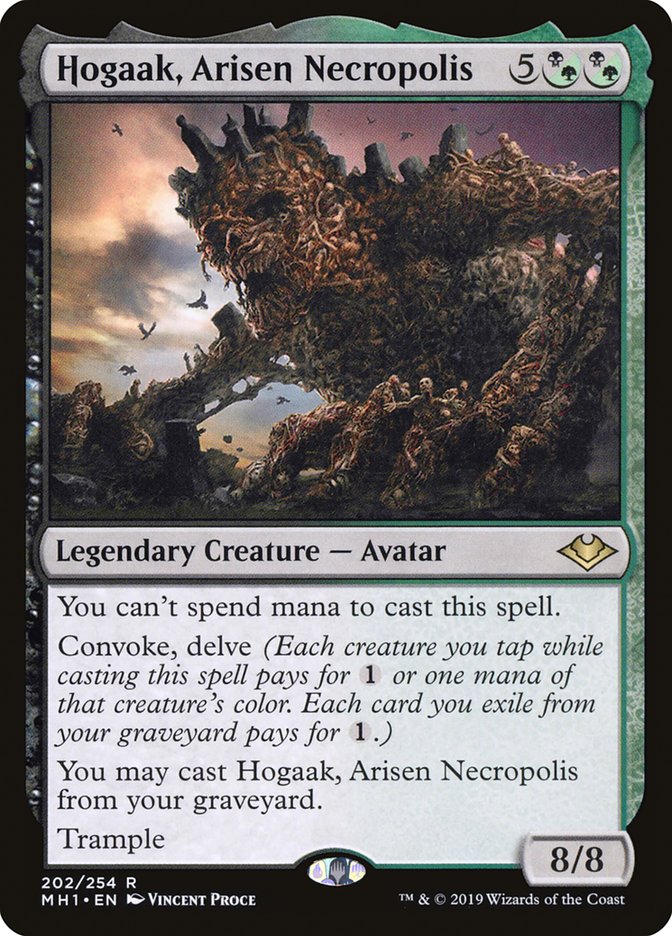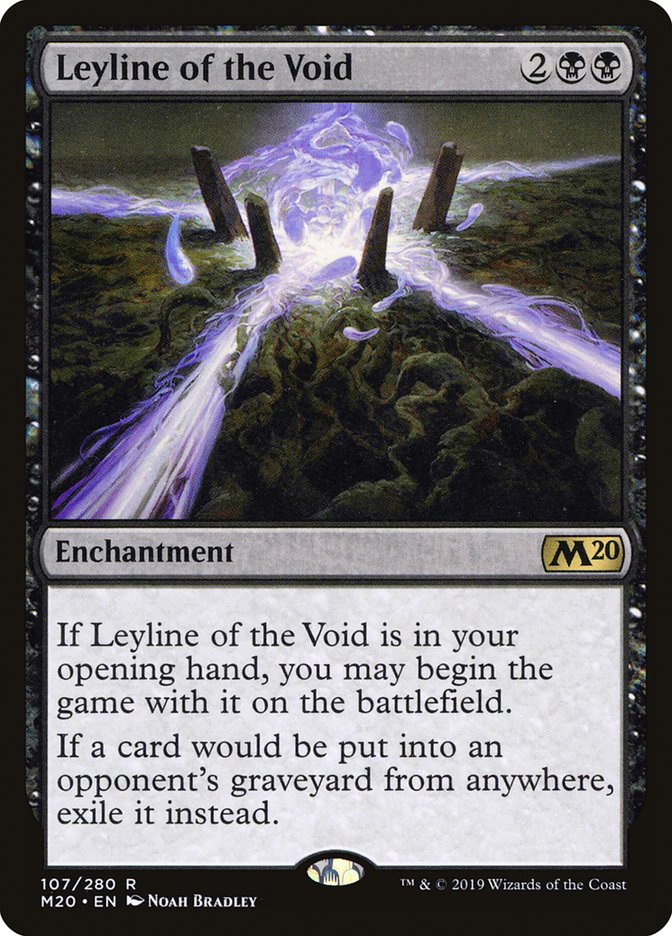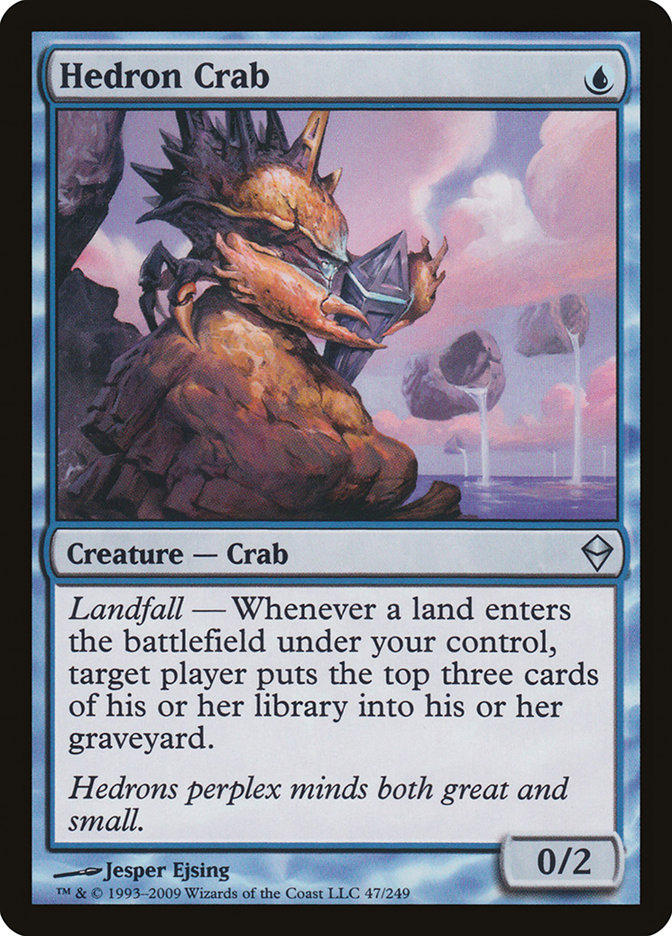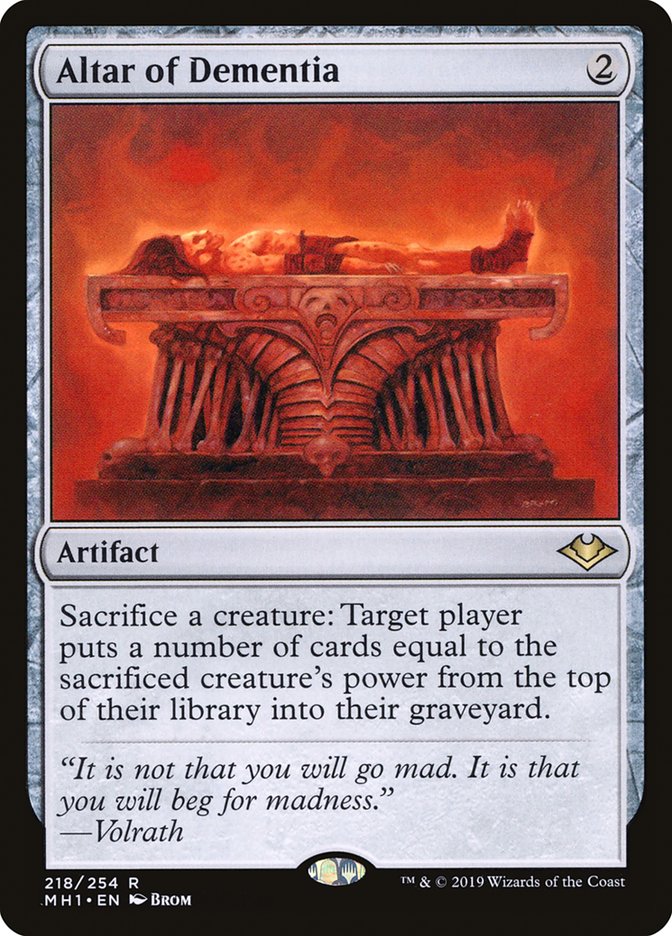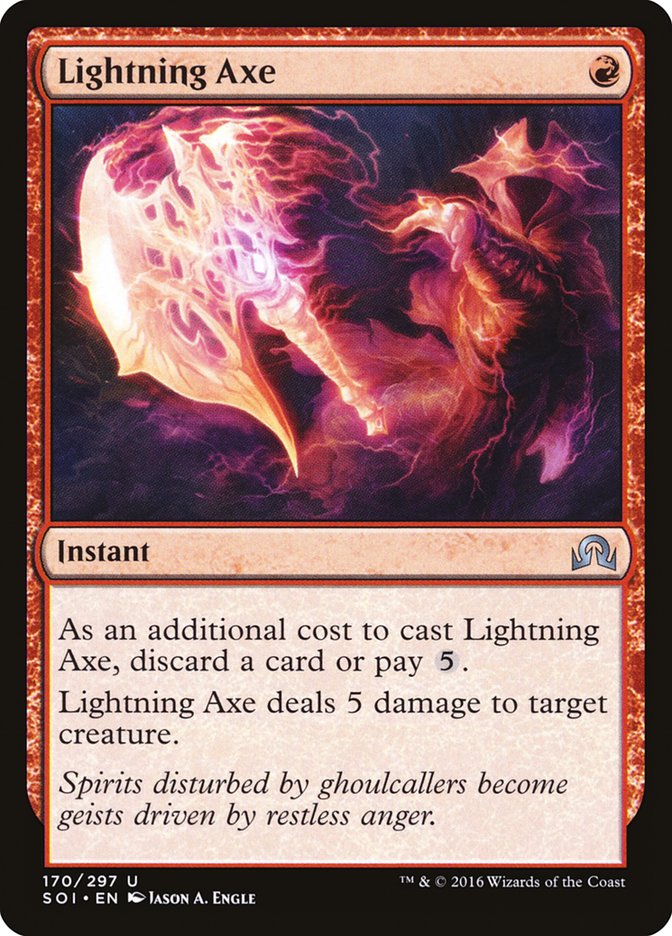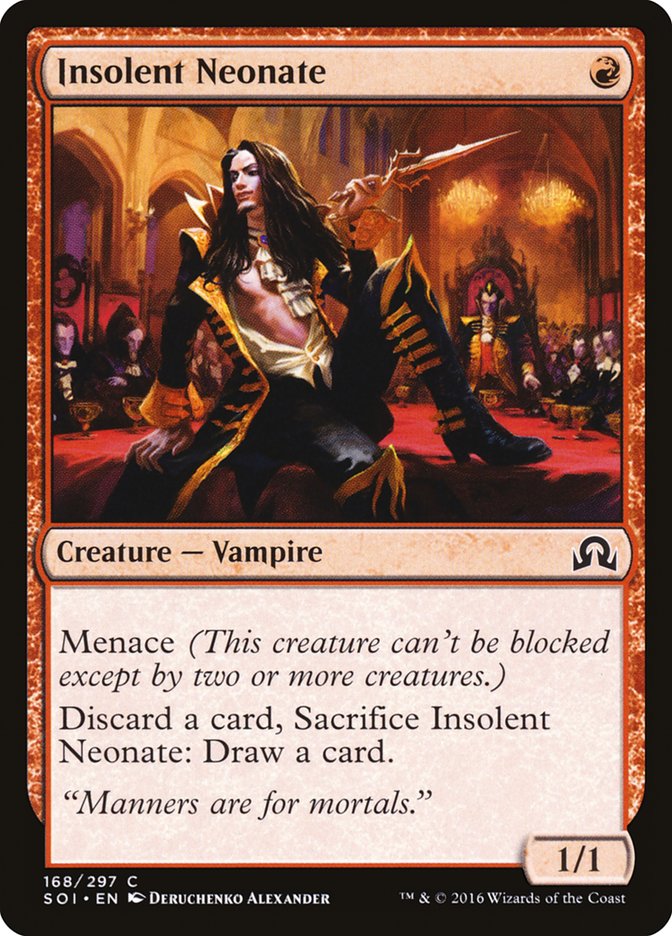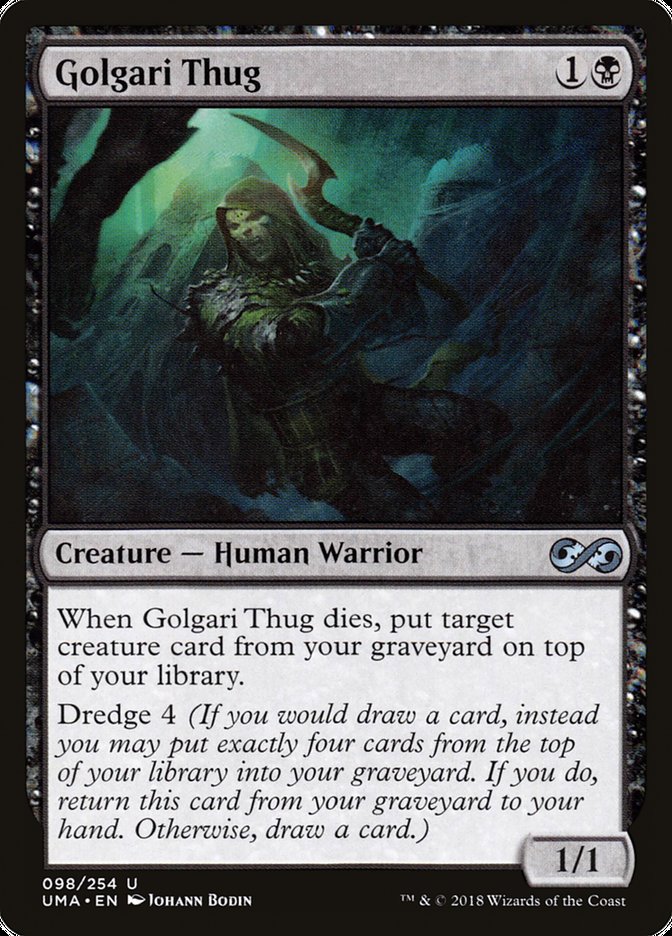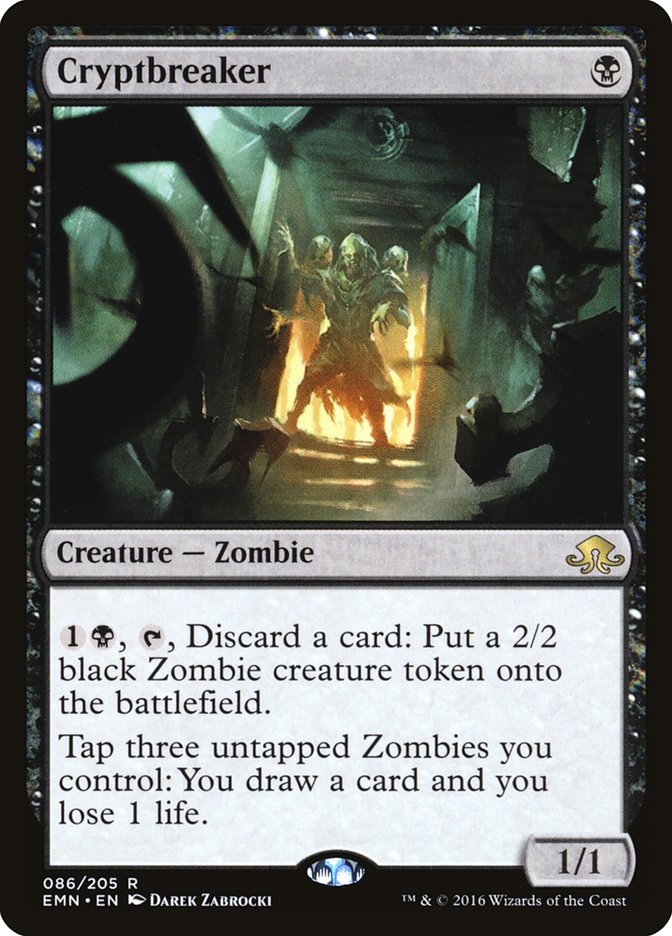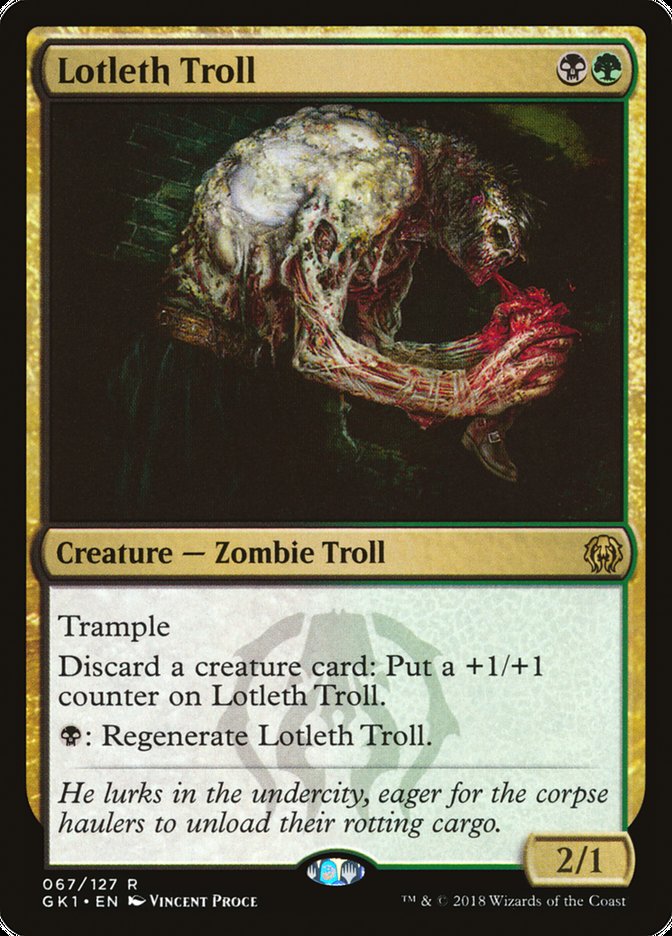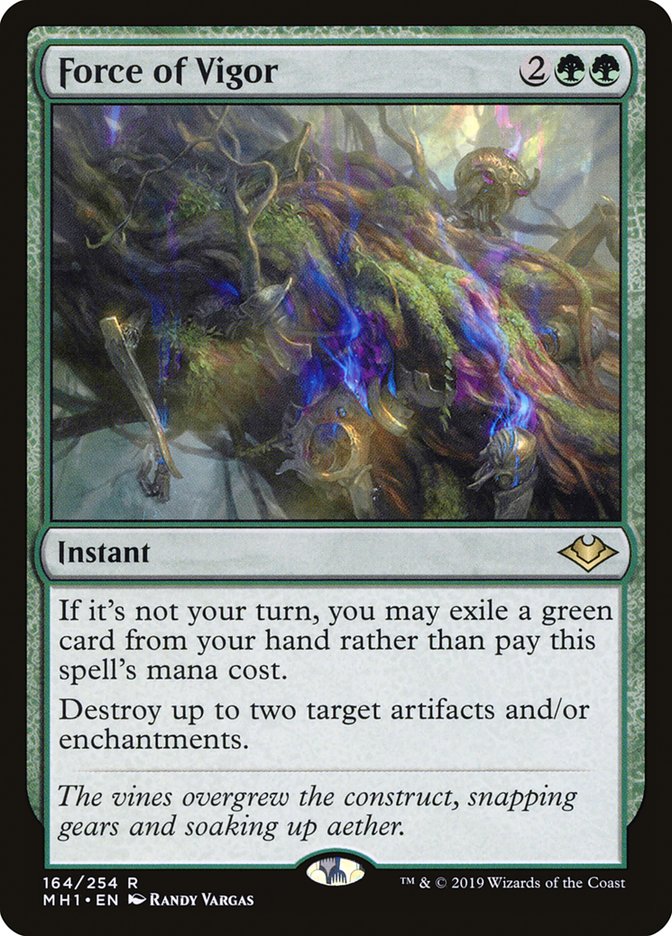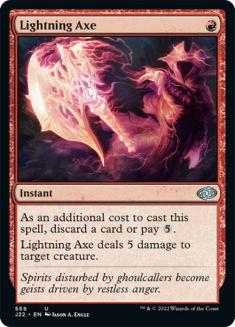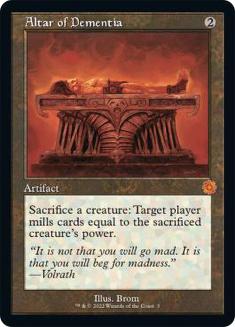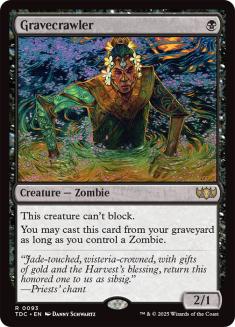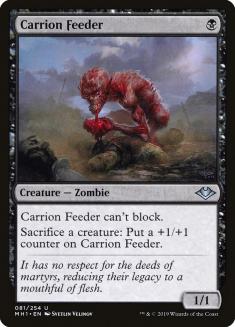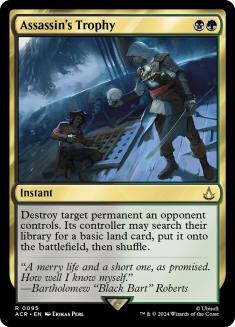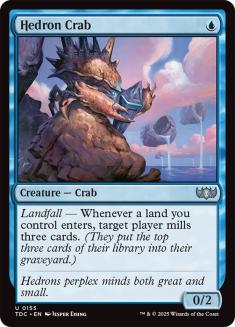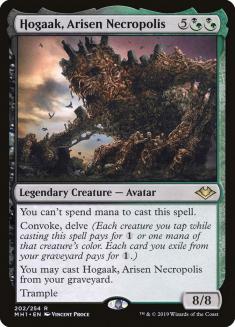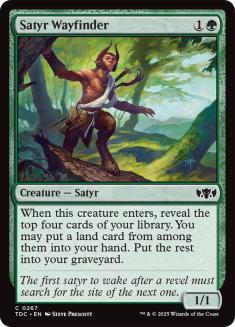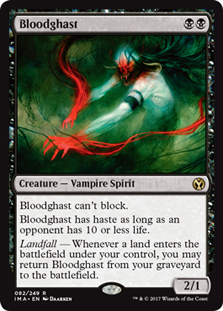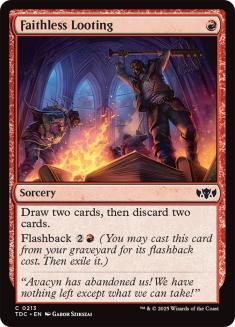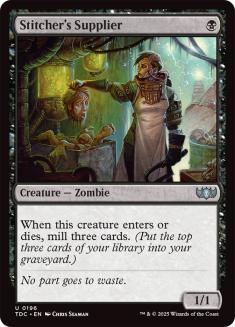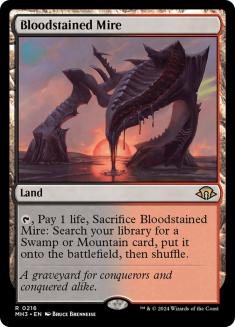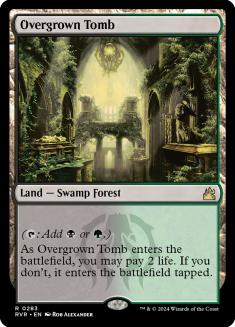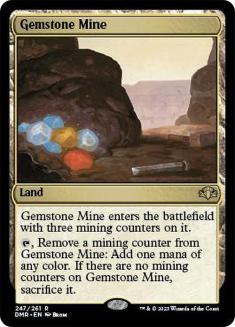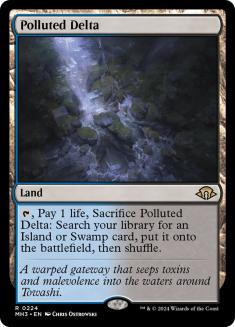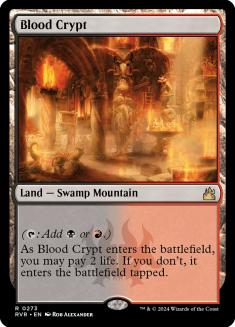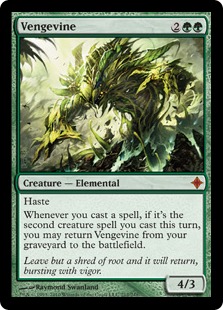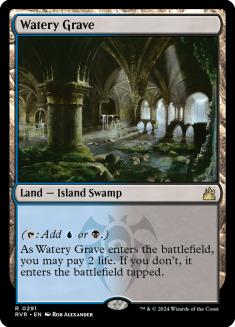Everyone understands Hogaak is a very powerful Modern deck, but there is divergence on how powerful. Personally, I believe it is stronger than Eldrazi was when it was first released, as it’s both faster and more consistent; it’s not that hard to present an insurmountable battlefield as early as Turn 2, which results in a fair number of Turn 3 wins.
By itself this wouldn’t be enough to call the deck broken, since there are several Modern decks that are capable of even earlier kills, but the key is that these decks all give up something for their explosiveness, while Hogaak just doesn’t. The fact that you can either draw or mill your important cards means you’re remarkably consistent at finding them, and the fact that you can replay everything from the graveyard makes you resilient to most forms of interaction that are commonly played in maindecks (removal, discard, counterspells, or even blocking).
If you take decks like Storm, Amulet Titan, or Neobrand, they can also kill quickly, but if something goes wrong, they crumble and do nothing. If something goes wrong with Hogaak, they just kill you a turn later instead. This combination of power, speed, consistency and resiliency is unmatched by anything in the format.
Since you can’t expect Hogaak to reliably fizzle and you can’t fight it with the cards you’d use to fight any other Magic deck, the only resort you have is to hate it out, and you have to be very particular about your hate, since the deck can often win through “soft hate” such as Nihil Spellbomb, Surgical Extraction, Relic of Progenitus, or even Ravenous Trap. You really need to stop them from playing the game to begin with.
This was the avenue chosen by most of the Mythic Championship, as Leyline of the Void was the most-played card in the tournament with over two copies per player, several of them in the maindeck. This is an unprecedented level of hate, and it was still not enough to stop the Hogaak menace. Hogaak was the most-played and also the best-performing deck in the tournament, with over half the 8-2 records. It only placed one player in the Top 8, but I believe that was simply due to wins being badly distributed, partly because it was a split format and partly because the deck was cannibalized by the players who chose to play maindeck Leyline in it, increasing their win percentage in mirrors but lowering it across the field (so the people who won the most mirrors also lost the most other matchups, give or take).
Here’s the decklist I played for an 8-2 result at the Mythic Championship:
Creatures (31)
- 4 Carrion Feeder
- 4 Bloodghast
- 4 Hedron Crab
- 4 Vengevine
- 4 Gravecrawler
- 3 Satyr Wayfinder
- 4 Stitcher's Supplier
- 4 Hogaak, Arisen Necropolis
Lands (20)
Spells (9)

I believe the core of the deck is basically locked in (Hogaak, Arisen Necropolis; Vengevine; Faithless Looting; Stitcher’s Supplier; Bloodghast; Gravecrawler; Carrion Feeder) but there is a lot of variation on the last slots. Here are your options:
Satyr Wayfinder is almost a core part of the deck at this point, since I believe almost everyone played it. It’s not the fastest card, but it does enable Turn 2 Hogaaks reliably, and it’s an important card in sideboard games where you might actually want to hit your land drops to hardcast Vengevine.
This card separated our builds from most other builds. Almost everyone identified Hedron Crab as strong in the deck, but most people didn’t feel it was worth the manabase sacrifices. We disagreed, feeling that, even though the manabase got meaningfully worse, it was still too good a card not to play.
There are two reasons I feel Hedron Crab is worth it. The first is that it’s very explosive. Your fastest draws often include Crab, as it can mill for twelve cards over the course of two turns. It is a crucial card in mirrors, as well as against Humans and decks like Grixis Urza that cannot interact with it. The second reason is that it is, by itself, a powerful milling engine. If you’re playing a game where your opponent is disrupting your cards and your graveyard and you’re trading resources back and forth, then if you are going to have one card left standing, you probably want that to be the Crab, since it’s enough to kickstart you back into the game after any number of Nihil Spellbombs, Ravenous Traps, and Relics of Progenitus.
This was the other card that we had and almost no one else did. It’s easy to assume that, since Bridge from Below got banned, the other half of the combo (the Altar of Dementia) should just leave the deck as well, but we identified early on that Altar was actually relevant even without Bridge. A lot of the mirrors come down to battlefield stalls, where players are just attacking, blocking, and recasting Vengevines and Hogaaks. Altar singlehandedly wins those.
It also has strong applications versus Humans (by denying Reflector Mage and Deputy of Detention and by letting you win through multiple Auriok Champion), Death’s Shadow (so you can kill them without enabling their Death’s Shadows), and Ensnaring Bridge decks (even if they Karn for Bridge, you can sometimes kill Karn with your small creatures and then Altar mills them out). Since Altar did all of that while also being just part of your regular milling plan, we felt it was still a good addition to the deck. Between Crabs and Altars, we felt advantaged in all the mirror matches that didn’t include Leyline of the Void.
Altar of Dementia is going to come out in almost all the matchups, as it’s not part of your main core and therefore something you can remove without disrupting your game plan too much (but this would likely be true of any card in this slot). It’s also much worse against graveyard hate of any kind. The only matchup I keep Altar of Dementia in post-sideboard is Humans.
One caveat about Altar is that it’s an incredibly complicated card to play with. The Altar kill requires a lot of math that is often uncertain (you don’t know what you’re going to mill when you start the process, so you have to account for a lot of different possibilities), and if you mess up it can be devastating (since there are tons of decks that can just kill you on their turn if you mill them halfway, like Phoenix, Dredge, or the mirror). If you’re playing this deck, I only recommend playing Altar of Dementia if you have time to practice with it; otherwise you’re probably going to be overwhelmed by the card.
A lot of teams played maindeck Leyline of the Void in their Hogaak builds. In fact, we almost did that as well. It is the single best card in Game 1 in the mirror, as any remotely functional hand with Leyline will beat any hand from the other side, and it does free up sideboard slots, but it’s not a strong card versus the field as a whole (even though it does have applications versus various decks, such as Izzet Phoenix, Azorius Control, and the Thopter Foundry / Sword of the Meek combo).
Most people who played Leyline didn’t like the last remaining cards in the deck anyway, so they felt they might as well play this trump for the mirror (which they identified as the best deck in the format). The difference between our build and the other builds is that we actually liked our last slots. We felt that Hedron Crab and Altar of Dementia were strong cards that we wanted to play with, so our Leyline slots weren’t as free as those of others. If my options had been Leyline of the Void or Golgari Thug / Insolent Neonate, then I would probably have played Leyline as well.
Another key aspect of playing Leyline: open decklists. With open decklists, you can actively mulligan for the card (though if you play only a couple of copies then you’re probably not going to do that). More importantly, you know when the card is good, so you know how to value hands based on the fact that they contain a Leyline of the Void. A hand of five lands, Stitcher’s Supplier, and Leyline of the Void is a good hand in Game 1 of a Hogaak mirror, but not a keepable hand anywhere else, so what do you do if you open this hand in an unknown matchup? You can’t afford to keep it, but then it might turn out they are playing the mirror and you gave up a free win.
Open decklists also let you know when to put back Leyline of the Void after a mulligan, or even when not to play your Leyline of the Void at all. If I’m playing versus Humans, for example, I’d rather have the card in my hand to discard to Faithless Looting and Lightning Axe than have it on the battlefield, but if you’re playing without decklists, then you’re always going to put it on the battlefield.
Overall, I believe playing maindeck Leyline of the Void was potentially a smart choice at the Mythic Championship, but it is not a good choice for any tournament without decklists. If you’re playing any regular tournament, I would not recommend you maindeck Leyline, which makes our version of the deck even better (since it has advantages versus the normal Hogaak build that are not dependent on known decklists).
The removal spells are concessions to the other decks in the field: Humans, Izzet Phoenix, and all Devoted Druid builds (though these were basically absent from the Mythic Championship). I think drawing the first Lightning Axe in Game 1 is usually better than drawing the first Fatal Push, but drawing the second Lightning Axe is often bad, so I opted for the two Lightning Axe / one Fatal Push split. This is also relevant post-sideboard, since the game slows down, your graveyard is attacked, and resources become more important, which makes Lightning Axe more of a liability. Ina matchup like Jund, for example, you want removal to deal with Scavenging Ooze but you’re not interested in having to discard a card against so many disruption spells.
I believe Insolent Neonate is just a weak card. I understand it can be used to return Vengevine to the battlefield, since it’s a creature, but it does basically nothing else, and the effect is too minor. I would not play this card.
Somehow even a weaker card than Insolent Neonate. Drawing a card is actually relevant with this deck, since you’re often trying to draw a cheap creature to recur Vengevine (often with only one mana available, which means you can’t just dredge Golgari Thug in a lot of spots where this would be true) or a land to recur multiple Bloodghasts. There are some cool tricks you can perform with it (for example, if your opponent casts Surgical Extraction, you can sacrifice Golgari Thug and put their Extraction target back on top of your deck), but overall I don’t believe it to be worth playing. The icing on the cake is that the effect is not optional; it’s not common, but it does happen that your opponent kills your Golgari Thug and you have to return it, and let me tell you, being locked into drawing Golgari Thug yet another turn is not nice.
The best (and only, really) good thing about this card is that it’s a one-mana black Zombie. I’ve never found it to be particularly good other than exactly against Azorius Control post-sideboard, and even then it’s not that good because your best plan is to have an explosive draw and Cryptbreaker makes you adopt a more controlled game, which plays into their gameplan. I would stay away.
We never tested this card, but it looks reasonable to me, as the regeneration can actually be good in a lot of matchups (for example Jund). I like the cards we played in this slot but if you’re stuck with Golgari Thugs or Insolent Neonate, I think this is an upgrade to it.
How to Sideboard
The Hogaak sideboard is almost all about Leyline of the Void: either bringing in your own or answering your opponent’s. Most of the time, it will be incredibly obvious what should come in, and then you’ll take out a couple of cards that are also incredibly obvious, and struggle to take out the remaining two or three. I recommend that, when in these spots, you take out a combination of Gravecrawlers and Carrion Feeders, as I believe it’s more important to have the enablers in your deck than the payoffs.
The one tricky part is that most of the sideboard is dedicated to answering what people have against you, and you’re probably not going to have decklists like we did. At the Mythic Championship, for example, I played against a Bant deck whose hate was Surgical Extraction and Bojuka Bog, so I knew I didn’t have to bring in Leyline removal versus this player. I also played against a Humans deck that had both Leyline of the Void and Grafdigger’s Cage, so I knew I had to bring in all my hate answers, even though I might not if they had Ravenous Trap instead. In a tournament without decklists, you probably have to hedge a little and accept that your answers are sometimes going to be mismatched.
We didn’t play Force of Vigor, but I think there’s a chance it’s just better than Nature’s Claim. Destroying two cards against Grixis Urza and Eldrazi Tron is huge, and it dodges discard spells versus Jund even if you are on the draw. It is a worse topdeck than Nature’s Claim (since you can’t immediately cast it) and it does require pitching a green card (and most of your green cards are not superfluous), so there are definitely downsides, but it’s an option to consider moving forward, especially if Eldrazi Tron and Grixis Urza decks become more popular.
Here’s a rough sideboard guide for the most common matchups. If you play Force of Vigor instead of Nature’s Claim, you can just substitute those.
VS Hogaak
Out:
In:
Altar of Dementia is a very good card in Game 1, but post-sideboard it loses a lot of its effectiveness as the Leyline subgame is usually the decider (plus, it randomly gets hit by all the Leyline hate).
When you’re playing the mirror post-sideboard, your opening hand must contain either a Leyline of the Void or an answer to Leyline of the Void, and I would not keep an otherwise perfect seven-card hand that didn’t have either of those. I would keep an otherwise perfect hand on six cards, though, as there’s always the chance they kept a regular hand with an answer to Leyline (but no Leyline itself) and then you’ll win. All in all, this is a silly subgame and unless you have both a Leyline and an answer with a functional hand, you must hope you have the right card for what they have.
If you play Force of Vigor (three or four copies), I would consider choosing to draw. The extra card will be more important since you’re all mulliganing and you require another green card for Force, and it gives you the chance to snipe the Leyline before you play your Turn 1 (whereas if you are on the play, your Turn 1 is wasted). However, this makes Assassin’s Trophy much worse as an answer and overall being on the play is great in this matchup, so I cannot strongly recommend it without trying it more myself. It’s just something that some people at the tournament were doing and that made some sense to me, but I haven’t personally tested it, since I never at any point had that many Force of Vigors in my deck.
VS Izzet Phoenix
Out:
In:
The main card that beats you here is Thing in the Ice, so you want all your answers. Thoughtseize is a preemptive answer to it and also gets rid of Surgical Extraction and Ravenous Trap, which are the most common forms of hate they play. They draw a lot of cards throughout the game and also care about playing spells, so there’s an enormous cost in playing Leyline of the Void instead of the spell-based hate, but if they do go that route, then you should swap Thoughtseizes for Leyline removal. Whatever you do, do not sideboard in Leyline of the Void against them.
VS Azorius Control
Out (on the play):
In (on the play):
Out (on the draw):
In (on the draw):
Game 2 is usually unfavorable for you here, but that’s okay because you’re a massive favorite Game 1, so you usually have to win only one of the two post-sideboarded games. Their strongest hate here is Rest in Peace, which comes down on your explosive turn (Turn 2), which is why there’s a difference in play-draw. If you’re on the play, I prefer to just brute-force through it, as you can usually establish a battlefield before they even get to cast Rest in Peace, whereas if you’re on the draw, it’s impossible to do that and you must answer it and therefore play a slower game.
VS Humans
Out:
In:
This is the trickiest matchup to sideboard for without decklists. In the dark, I’d err on the side of bringing in a couple of Nature’s Claims, as they can also target Aether Vial (though some people take some number of Vials out in sideboard games). If you know or suspect their hate is Ravenous Trap, you don’t need to bring any Nature’s Claims.
VS Jund
Out:
In:
This matchup is almost all about Leyline of the Void, as their Game 1 configuration is so inefficient at dealing with what your deck is trying to do. The Leyline games are tough, especially since they can discard your answers if they are on the play (or if you have Assassin’s Trophy), but you also only have to win one out of two games here the majority of the time, so it’s still a good matchup. Some people don’t have Leyline of the Void (having an assortment of other hate cards instead) and they usually can’t put up a fight.
VS Eldrazi Tron
Out:
In:
This is one matchup where they actually benefit from open decklists, as the Eldrazi half of their deck does nothing, so they can’t keep a hand that they normally would keep. For example, Turn 2 Matter Reshaper into Thought-Knot Seer into Reality Smasher is a very good hand versus some people, but has almost no chance of beating a regular Hogaak hand, and they’re better off mulliganing into Chalice of the Void or early Karn, The Great Creator for Ensnaring Bridge. In fact, they win a surprisingly high number of games in which they mulligan to four and have Urzatron plus Karn, because the low number of starting cards means Ensnaring Bridge is immediately effective.
They have some big creatures, so you might be tempted to keep in removal, but that’s really not the arena the game is decided on. It’s all about Leyline, Chalice and Bridge. The creatures are basically irrelevant and you should not be trying to answer them.
This is also a matchup where Force of Vigor is roughly ten times better than Nature’s Claim. Destroying a Leyline of the Void and an artifact (Chalice of the Void or Expedition Map) comes up quite often, and just having your answer to both Chalice and Leyline not cost one is a huge deal. If this matchup is very popular, that would almost singlehandedly get me to make the switch.
Sequencing
This deck gives you a lot of free wins, but it’s actually incredibly hard to play properly, as you often have to sequence your lands and spells considering not only what you have but what you might draw (especially with Hedron Crab in your deck). This is absolutely not a deck you can play on autopilot, as each card you draw or mill (or each card you don’t mill) changes a fork down the road, and all the cards are unforgiving when it comes to timing. If you hit Vengevine but after you’ve played two creatures, it doesn’t work. If you hit Bloodghast or Hedron Crab after you’ve played your land, it doesn’t work. If you hit Gravecrawler after you’ve sacrificed your Stitcher’s Supplier, it doesn’t work. If you hit Hogaak but played a blue creature instead of a black one, it doesn’t work.
The key principles I use for sequencing are these:
- I want to be able to get a Vengevine on the battlefield on Turn 2. This means that, if given the choice, I will cast Faithless Looting on Turn 1 and then two other creatures on Turn 2.
- I want to be able to cast a Hogaak on Turn 2. This means that, if my Turn 2 is going to be Satyr Wayfinder, I will do my best to cast a black creature Turn 1.
- I want to avoid exposing Hedron Crab to removal spells. This means that, if possible, I cast it on Turn 2, right before playing a land.
Sometimes these goals are at odds, and you have to figure out which one is most important given the contents of your hand and the matchup. Let’s take some opening hands as examples (of seven or six cards, because sometimes you mulligan):
Opening Hand #1
Here, I believe the correct sequence is:
Turn 1: Gemstone Mine, Faithless Looting.
Turn 2: Hedron Crab, fetchland, sacrifice fetchland, Stitcher’s Supplier.
This maximizes all of the above points. It guarantees two creatures on Turn 2 in case you put a Vengevine in the graveyard and it avoids exposing your Hedron Crab. You do lose counters on your Gemstone Mine, but this is not nearly as relevant as maximizing your early-game chances. You almost never need to use Gemstone Mine more than three times in a game (and it can even sometimes be a benefit to sacrifice it because of Hogaak), so do not be afraid of leading on it if that will make for a better Turns 1 and 2. This is also the reason Steam Vents is in the deck. You often want to lead on Faithless Looting and then cast Hedron Crab on Turn 2 without making your land drop, and the only land you can fetch to do that is Steam Vents (though in this case you don’t need to do that since you have Gemstone Mine).
Opening Hand #2
I would sequence this as:
Turn 1: Polluted Delta, fetch Watery Grave, cast Stitcher’s Supplier.
Turn 2: Varies.
- If I milled (or drew) Hogaak, I’d cast Satyr Wayfinder and Hogaak.
- If I milled Vengevine and drew a one-drop, I’d cast Crab plus the one-drop to return Vengevine.
- If I drew nothing and milled nothing, I’d cast Satyr Wayfinder. Then, if I mill Hogaak, I can cast that, but if I don’t, I can cast Hedron Crab, play a fetchland, and Bloodghast on Turn 3 and potentially get Vengevines back.
- If I milled nothing but drew a Gravecrawler, then I would cast Hedron Crab and play a fetchland this turn. If I then mill into Vengevine or Hogaak with the Crab, I cast Gravecrawler; otherwise I hold it for Turn 3 so I can go Bloodghast plus Gravecrawler.
- If I milled no Vengevines or Hogaaks but drew a Carrion Feeder, then I would cast Hedron Crab and play a fetchland this turn. If I manage to get a Bloodghast on the battlefield via the first six mills, then I cast the Carrion Feeder and sacrifice the Stitcher’s Supplier to try to find Hogaak (since the Bloodghast lets me cast it anyway).
Opening Hand #3
Turn 1: Polluted Delta, go. At the end of the turn, fetch Watery Grave.
Turn 2: Cast Stitcher’s Supplier, play Blood Crypt, and cast another Stitcher’s Supplier.
Holding your Stitcher’s Supplier on Turn 1 lets you get Vengevine if you mill it on Turn 2 and doesn’t impact your ability to cast Hogaak if you hit it.
Opening Hand #4
Post-sideboard versus the mirror. Your opening hand is:
Your opponent drops Turn 0 Leyline of the Void (and so do you).
Turn 1: Polluted Delta, fetch Watery Grave, Hedron Crab.
Turn 2: Polluted Delta, stack Crab, fetch Overgrown Tomb, stack Crab, Nature’s Claim the Leyline, Crab triggers resolve.
There’s no Breeding Pool in the deck, so you cannot cast Turn 1 Nature’s Claim and still maximize Crab activations if you don’t do exactly this.
Opening Hand #5
Turn 1: Bloodstained Mire, fetch Blood Crypt, Stitcher’s Supplier.
You need to play a fetchland Turn 1 here because you need another card in your graveyard to play Hogaak and your best shot is either drawing another one-drop creature or simply drawing another fetchland. If you don’t play the Bloodstained Mire and you draw another fetchland, that’s too late for Hogaak.
These are just some examples, but they show that a lot of the decisions with this deck aren’t obvious, and you really have to consider everything that could happen at all times.
Altar of Dementia Kills
Altar of Dementia kills are complex and you need to think about them before you start going off, because if you mess it up, then it could be too late. Here’s the heuristic we developed for Altar Math:
1. Count the number of black or green creatures you have and figure out how many times you can cast Hogaak. This is usually your limiting factor (more so than cards in your own graveyard). Each two creatures translate into one Hogaak, unless you have a second Hogaak in the graveyard, in which case each creature translates into one Hogaak (since you can do the trick where you tap a Hogaak to cast the next one and then sacrifice it for Altar before the second one enters the battlefield). It’s much easier to Altar-kill when you have access to two Hogaaks.
2. After this, multiply the number of times you can cast Hogaak by five, and that’s how many cards you will need in your graveyard. Do not forget to count the creatures that are on the battlefield and will be sacrificed; all but two will be needed (the last two must remain alive to cast the final Hogaak). Then, mill yourself until you reach that number. As a general rule, if you can cast more Hogaaks (because you have more creatures untapped) it is always best to do so, as each Hogaak mills eight cards but only costs five cards, so you should always mill yourself more if that’s what’s stopping you. If you can do this earlier in the process, that’s even better, as it increases your chances of hitting Vengevines and Bloodghasts.
3. Figure out how many total cards you can mill. Each time you can target them with Hogaak, you will mill for eight, so you need to add all the times you’re playing Hogaak but subtract all the times you’re targeting yourself. Don’t forget to also count the milling for the creatures that are on the battlefield.
4. If the total amount is equal to or higher than the number of cards in their library, go for it.
Here’s a simple example to illustrate the point.
Imagine your battlefield is four Bloodghasts and an Altar of Dementia (and you can’t recur anything this turn). Your graveyard is two Hogaaks and eight other cards in your graveyard.
First, we count the number of Hogaaks. The first two Bloodghasts cast the first Hogaak, and the third and fourth Bloodghast each cast a Hogaak, so we’re casting Hogaak three times. For that, we need fifteen cards in the graveyard. We already have eight, but three Bloodghasts can be sacrificed before the last Hogaak is cast, so that’s eleven cards that will be in the graveyard (the last Bloodghast and the Hogaak need to stay on the battlefield). So we need to mill four more of our own cards, which means two Bloodghast mills have to target us. We can then mill the opponent for the three Hogaaks and the two remaining Bloodghasts, adding up to 28 cards.
In an actual game, things will rarely be this clear-cut, as there’s always the chance you can bring back more Bloodghasts or Vengevines by milling yourself first and you don’t actually know what you’re hitting until you hit it (for example, you might not have a second Hogaak and have to hit that), but this is the general process.
Odds and Ends
- You don’t have to select a land with Satyr Wayfinder. Sometimes it’s better to put it in the graveyard so you can exile it to Hogaak. This is very common when your draw involves a Turn 1 Gravecrawler or Carrion Feeder and a Turn 2 Satyr Wayfinder.
- Don’t forget to sacrifice your Bloodghasts and Vengevines to Carrion Feeder when they’re just going to come back anyway.
- Unlike most creatures with sacrifice abilities, Carrion Feeder can sacrifice itself. I won a game at the Mythic Championship because my opponent blocked two Vengevines with two Death’s Shadows, expecting the Carrion Feeder that got through to lower their life total enough that the Death’s Shadows would survive combat. Then I just sacrificed the Carrion Feeder and both Death’s Shadows died.
- Hogaak tramples, so you can use it with removal spells for surprise damage. I won a game at the Mythic Championship by casting Lightning Axe on my opponent’s Hogaak when they blocked my Hogaak and trampling for five points of damage.
- You only have one of each shockland except for Overgrown Tomb, so if you need a specific one, you should consider fetching with your mills on the stack when you have Hedron Crab so you don’t risk milling it.
- The best way to play around Ravenous Trap is to do your actions one at a time and never stack your effects. If you ever hit a Hogaak, just cast it immediately so they don’t have a window to Ravenous Trap you.
What’s Next
Moving forward, I believe the list we used is the best-positioned because I don’t think playing Leyline is advisable in a field without decklists and our list is the best for the mirror aside from the Leyline version. Our list felt well-tuned and I liked everything we had, and the one card I would try out in the sideboard is multiple copies of Force of Vigor instead of Nature’s Claim.
There’s been a lot of conversation on whether something else from the Hogaak should be banned, and I believe the answer is yes. It warped the metagame like nothing has ever done before, and it was still the best deck. If people stop playing Leyline maindeck in Hogaak, it will be even better against the rest of the field. At this point, I’m not sure even banning an enabler (like Faithless Looting) would do it; Hogaak is simply too strong a card as an 8/8 trampler for zero mana that you don’t even need to draw and that can be replayed at will.
Whatever their decision is, however, it will be a while before it gets implemented, so you’re probably resigned to either playing Hogaak (which is what I would do) or trying to beat it. If you’re trying to beat it, you should know that cards like Surgical Extraction, Nihil Spellbomb, Ravenous Trap and Relic of Progenitus do very little. I would also not recommend playing a deck that gets smashed by Hogaak but that can try to win with strong hate (such as Jund with Leyline or Azorius Control with Rest in Peace) because you’ll almost always lose Game 1 and then winning both sideboard games is much harder.
My recommendation would be to play a deck that naturally has decent game against Hogaak and then play the sideboard hate on top of that. These decks are, in my opinion, Eldrazi Tron, Humans, Grixis Urza, Mono-Red Prowess, and Devoted Druid decks. These all naturally have game or even are favored versus Hogaak without having to sacrifice too much in all the other matchups.
Hogaak is likely to get banned in the next announcement, but until it doesn’t, your best chance to win is just playing the deck. It’s too much better than everything else.


